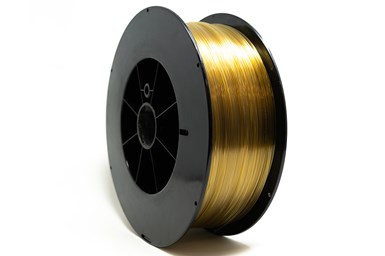Essentium Launches PEKK High-Performance Material
RAPID 2021: PEKK shares most of the performance attributes of PEEK, but has a lower crystallization rate and is less affected by the cooling process once the part is 3D printed, thereby minimizing warping.
Share

Essentium’s PEKK is said to ensure manufacturers can quickly produce parts that meet their industry’s reliability, repeatability and performance standards.
Essentium’s PEKK, made with an Arkema 6002 Kepstan resin, is an ultra-polymer offering high heat and chemical resistance as well as mechanical strength to meet the performance requirements of aerospace and industrial applications.
The company says PEKK shares most of the performance attributes of PEEK, but has a lower crystallization rate and can therefore be treated as an amorphous polymer. This means it is less affected by the cooling process once the part is 3D printed, thereby minimizing warping. PEKK is said to maintain the flame smoke toxicity ratings for Federal Aviation Regulations (FAR) compliance, while offering improved resistance to chemical attack compared to PEI materials. PEKK has an extrusion temperature between 340 and 400°C.
The material extends Essentium’s open additive manufacturing (AM) ecosystem by enabling manufacturers to scale and meet the requirements of their specific applications with tested and certified materials of their choice. Essentium’s PEKK is said to ensure manufacturers can quickly produce parts that meet their industry’s reliability, repeatability and performance standards.
The material is well-suited for industries that want AM to give them speed to parts without sacrificing quality, enabling the rapid production of complex parts for harsh and extreme environments on-demand, the company says.
Related Content
-
AM 101: Digital Light Synthesis (DLS)
Digital Light Synthesis (DLS) is the name for Carbon's resin-based 3D printing process. How it works and how it differs from stereolithography.
-
How Large-Format 3D Printing Supports Micro-Scale Hydropower
There is potential hydroelectric power that has never been unlocked because of the difficulty in capturing it. At Cadens, additive manufacturing is the key to customizing micro-scale water turbine systems to generate electricity from smaller dams and waterways.
-
Possibilities From Electroplating 3D Printed Plastic Parts
Adding layers of nickel or copper to 3D printed polymer can impart desired properties such as electrical conductivity, EMI shielding, abrasion resistance and improved strength — approaching and even exceeding 3D printed metal, according to RePliForm.











